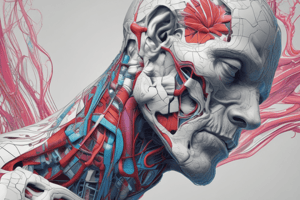Podcast
Questions and Answers
What is the main function of the vertebral column?
What is the main function of the vertebral column?
- To protect the brain
- To provide the main central support for the human body (correct)
- To produce force to move the body
- To regulate energy metabolism
Which type of joint is immovable?
Which type of joint is immovable?
- Cartilaginous joint
- Synovial joint
- Skeletal joint
- Fibrous joint (correct)
What is the function of skeletal muscles?
What is the function of skeletal muscles?
- To support the immune system
- To produce force to move the body (correct)
- To protect the brain
- To regulate energy metabolism
What is osteoporosis characterized by?
What is osteoporosis characterized by?
What is the term for genetic disorders that affect the development and growth of bones?
What is the term for genetic disorders that affect the development and growth of bones?
What is the primary function of the skeleton in terms of minerals?
What is the primary function of the skeleton in terms of minerals?
What is the main structural component of the skeletal system?
What is the main structural component of the skeletal system?
What type of bone is dense and hard?
What type of bone is dense and hard?
What is the role of osteoclasts in the skeletal system?
What is the role of osteoclasts in the skeletal system?
What is the main function of bones in the cranial and thoracic cavities?
What is the main function of bones in the cranial and thoracic cavities?
Study Notes
Skeletal System: Structure, Function, and Disorders
The skeletal system is a complex and essential organ system that gives structure to our bodies, provides support for the heart and lungs, protects internal organs, and is involved in movement and support for the muscular system. This article will explore the skeletal system, focusing on its structure, functions, and various disorders that can affect its health.
Skeletal Structure
The skeletal system is composed of bones, cartilage, muscles, nerves, and blood vessels. The main structural component is bone, which can be divided into two types: cortical bone, which is dense and hard, and cancellous bone, which is spongy and less dense. Bones are made up of three compartments: bone cells, extracellular organic matrix, and extracellular minerals. The main bone cells are osteoblasts, which form bone, osteoclasts, which resorb bone, and osteocytes, which are terminally differentiated osteolineage cells that play essential roles in skeletal development and homeostasis.
Bone Function and Homeostasis
The primary conventional functions of the skeleton include movement and protection, as well as serving as a reservoir of minerals, such as calcium and phosphate. Bones protect the internal organs of the cranial and thoracic cavities and house and protect the bone marrow within their cavities. The skeleton contributes to whole body homeostasis by regulating the function and homeostasis of extraskeletal organs and systems, such as hematopoiesis, immune activity, energy metabolism, and brain function.
Joint Types
Joints are the points where two or more bones meet, allowing for movement and connection. There are several types of joints, including synovial joints, which are the most common and allow for a wide range of motion; fibrous joints, which are immovable; and cartilaginous joints, which are found between bones like the ribs and sternum.
Skeletal Muscles
Skeletal muscles are attached to bones and contract to create movement. They are responsible for posture and support, as well as producing force to move the body.
Vertebral Column
The vertebral column, also known as the spine, is made up of many vertebrae that provide the main central support for the human body. It protects the spinal cord and allows for flexible movement. The spine has four main sections: cervical vertebrae, thoracic vertebrae, lumbar vertebrae, and the sacrum.
Skeletal Disorders
Various disorders can affect the skeletal system, including skeletal dysplasias, which are genetic disorders that affect the development and growth of bones; osteoporosis, which is a condition characterized by low bone mass and increased risk of fractures; and rheumatoid arthritis, an autoimmune disease that affects the joints and bones.
In conclusion, the skeletal system plays a crucial role in maintaining our body's structure, supporting our organs, and enabling movement. Understanding its structure, functions, and potential disorders can help us appreciate its importance and promote its health.
Studying That Suits You
Use AI to generate personalized quizzes and flashcards to suit your learning preferences.
Description
This quiz covers the structure, functions, and disorders of the skeletal system, including its components, types of joints, vertebral column, and various disorders that can affect its health. Learn about the importance of the skeletal system and how it supports our body.



